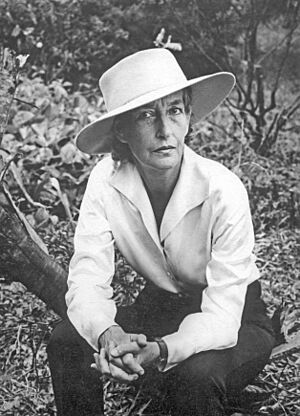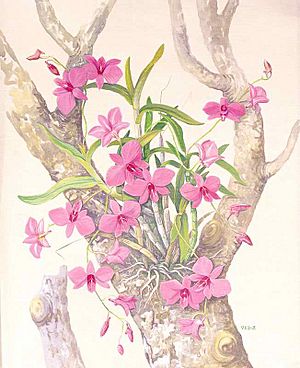Vera Scarth-Johnson facts for kids
Vera Scarth-Johnson (1912 – 19 May 1999) was a famous botanist and artist. She drew plants and taught people to love Australia's nature. She especially focused on the plants around Cooktown and the Endeavour River Valley in northern Queensland. This area is full of unique plants.
Contents
Vera's Early Life and Dreams
Vera Scarth-Johnson was born in 1912 in Morley, England. This town is near Leeds in Yorkshire. She went to school close to where Captain James Cook was born. Vera also studied art in Leeds and St. Albans.
She loved gardening from a young age. She wanted to work with plants. But it was hard for women to get jobs in horticulture back then. Vera worked in a market garden in Leeds. Later, her grandfather helped her start her own farm. She used the money to raise pigs and grow vegetables.
Life in Australia and Plant Discoveries
In 1947, Vera moved to Australia. After living in Victoria for a while, she moved to Queensland. She bought a farm near Bundaberg. First, she grew vegetables and tobacco. Then she switched to sugar cane. She was one of the first women to get a sugar cane farming permit. Vera worked very hard on her farm. She had many fun stories about being a cane farmer.
When farm work was slower, Vera drew and painted flowers. In the mid-1960s, she heard a radio interview. The head of the Royal Botanic Gardens in England was talking. He said that botany (the study of plants) needed more help. He mentioned that the gardens relied on volunteers worldwide. Vera wrote to him and sent some of her drawings. This started her long connection with Kew Gardens.
Vera paid for her own trips to collect plants. She traveled all over Australia and the Pacific Islands. Plant collections (called herbaria) in Australia, Europe, and North America greatly benefited from her work.
In 1972, when she was 60, Vera moved to Cooktown. She loved the beautiful Endeavour River valley. She started collecting and recording local native plants. She explored with her Aboriginal friends from the Guugu Yimithirr people. They found many plant types. They also recorded how these plants were used.
Vera was inspired by early botanists like Joseph Banks and Daniel Solander. They had traveled with Captain James Cook. She wanted to paint the amazing plants of the Cooktown area. Sadly, she developed Parkinson's disease. This meant she could only finish 160 paintings.
Sharing Her Art and Protecting Nature
In 1990, Vera gave her beautiful plant paintings to the people of Cooktown. She wanted everyone to enjoy and appreciate the plants of the Endeavour River area. Her collection is now shown at Nature's PowerHouse. This special building in the Cooktown Botanic Gardens was inspired by her.
Vera was a strong and lively person. She was tall, slim, and very kind. She loved spending time with friends, enjoying a glass of wine, and having good talks. She always spoke her mind. She shared her clear views with everyone. This included scientists, politicians, farmers, fishermen, and children.
Vera strongly campaigned against projects that could harm "her river." In the 1970s, there was a plan for a sand mine near the Endeavour River. Vera told people about this danger. Because of her efforts, the Endeavour River National Park was created. This park now protects the area.
In 1995, Vera received the Order of Australia Medal. This award recognized her important work in art and protecting the environment. Vera passed away in May 1999. She was surrounded by her loving friends and family.
The people of Cooktown are proud to care for her amazing collection of plant drawings. In 1989, Vera gave 140 of her drawings to Cooktown. These drawings show the flowering plants found in this special region.
Vera also helped create a wildlife reserve. It is a lovely heathland area of about 93.5 hectares (231 acres). It is about 17 km southeast of Bundaberg. In 2006, the Burnett Shire Council officially named it "The Vera Scarth-Johnson Wildflower Reserve."
Vera's Lasting Legacy
Vera hoped that the Nature's PowerHouse Interpretive Centre would teach people. She wanted current and future generations to learn about nature's wonders. She also wanted them to understand why we must protect the planet's untouched places.
Vera received the Medal of the Order of Australia (OAM) in June 1996. A rare shrub was named after her, called Argophyllum verae.
A book of Vera's collection is called National Treasures. This book helps Cooktown's worldwide reputation. It shows the town's important role in plant history and Australia's history. National Treasures has 152 full-color pictures of Vera's drawings. It also includes her notes and other interesting facts.
See also
 In Spanish: Vera Scarth-Johnson para niños
In Spanish: Vera Scarth-Johnson para niños



